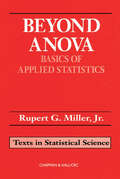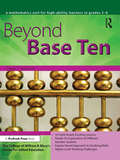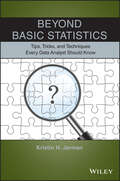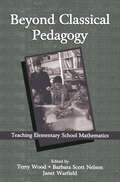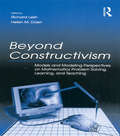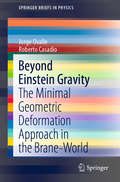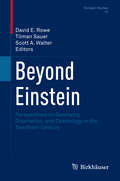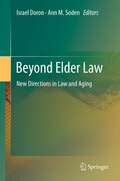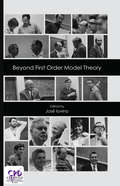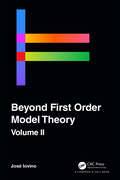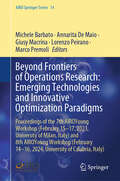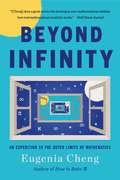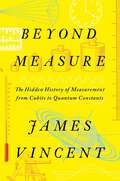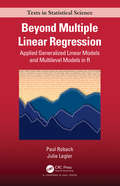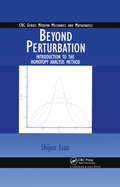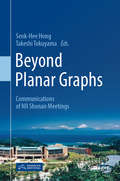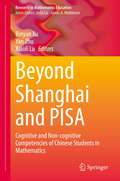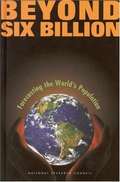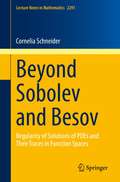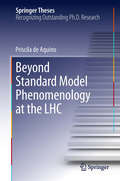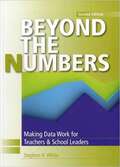- Table View
- List View
Beyond ANOVA: Basics of Applied Statistics (Chapman & Hall/CRC Texts in Statistical Science)
by Jr., Rupert MillerRenowned statistician R.G. Miller set the pace for statistics students with Beyond ANOVA: Basics of Applied Statistics. Designed to show students how to work with a set of "real world data," Miller's text goes beyond any specific discipline, and considers a whole variety of techniques from ANOVA to empirical Bayes methods; the jackknife, bootstrap
Beyond Base Ten: A Mathematics Unit for High-Ability Learners in Grades 3-6
by Dana T. JohnsonLooking for a way to challenge your gifted students in math class? Look no further! Beyond Base Ten investigates the concept of place value and the representation of numbers by using place value and non-place-value systems. Number bases other than Base Ten are featured, especially through historical contexts of early civilizations that developed number systems different from the one we use today.Place value is a fundamental and powerful concept that is the foundation for the number system used by all cultures. Typical curriculum materials address this concept in a rote method. This unit goes beyond this and encourages students to analyze the structure of our number system and other systems; examine the historical foundations of place value systems (Babylonian and Mayan) and non-place-value systems (Roman and Greek) over thousands of years in different civilizations; analyze why Base Ten is the surviving number system; and investigate applications of other number bases in areas such as computers and electricity. Beyond Base Ten is perfect for any student who loves mathematics!Beyond Base Ten was developed by the Center for Gifted Education at The College of William and Mary.Grades 3-6
Beyond Basic Statistics
by Kristin H. JarmanFeatures basic statistical concepts as a tool for thinking critically, wading through large quantities of information, and answering practical, everyday questions Written in an engaging and inviting manner, Beyond Basic Statistics: Tips, Tricks, and Techniques Every Data Analyst Should Know presents the more subjective side of statistics--the art of data analytics. Each chapter explores a different question using fun, common sense examples that illustrate the concepts, methods, and applications of statistical techniques. Without going into the specifics of theorems, propositions, or formulas, the book effectively demonstrates statistics as a useful problem-solving tool. In addition, the author demonstrates how statistics is a tool for thinking critically, wading through large volumes of information, and answering life's important questions. Beyond Basic Statistics: Tips, Tricks, and Techniques Every Data Analyst Should Know also features: Plentiful examples throughout aimed to strengthen readers' understanding of the statistical concepts and methods A step-by-step approach to elementary statistical topics such as sampling, hypothesis tests, outlier detection, normality tests, robust statistics, and multiple regression A case study in each chapter that illustrates the use of the presented techniques Highlights of well-known shortcomings that can lead to false conclusions An introduction to advanced techniques such as validation and bootstrapping Featuring examples that are engaging and non-application specific, the book appeals to a broad audience of students and professionals alike, specifically students of undergraduate statistics, managers, medical professionals, and anyone who has to make decisions based on raw data or compiled results.
Beyond Classical Pedagogy: Teaching Elementary School Mathematics (Studies in Mathematical Thinking and Learning Series)
by Terry Wood Barbara Scott Nelson Janet WarfieldThe emergence of the National Council of Teachers of Mathematics Standards in 1989 sparked a sea change in thinking about the nature and quality of mathematics instruction in U.S. schools. Much is known about transmission forms of mathematics teaching and the influence of this teaching on students' learning, but there is still little knowledge about the alternative forms of instruction that have evolved from the recent widespread efforts to reform mathematics education. Beyond Classical Pedagogy: Teaching Elementary School Mathematics reports on the current state of knowledge about these new instructional practices, which differ in significant ways from the traditional pedagogy that has permeated mathematics education in the past. This book provides a research-based view of the nature of facilitative teaching in its relatively mature form, along with opposing views and critique of this form of pedagogy. The focus is on elementary school mathematics classrooms, where the majority of the reform-based efforts have occurred, and on the micro level of teaching (classroom interaction) as a source for revealing the complexity involved in teaching, teachers' learning, and the impact of both on children's learning. The work in elementary mathematics teaching is situated in the larger context of research on teaching. Research and insights from three disciplinary perspectives are presented: the psychological perspective centers on facilitative teaching as a process of teachers' learning; the mathematical perspective focuses on the nature of the mathematical knowledge teachers need in order to engage in this form of teaching; the sociological perspective attends to the interactive process of meaning construction as teachers and students create intellectual communities in their classrooms. The multidisciplinary perspectives presented provide the editors with the necessary triangulation to provide confirming evidence and rich detail about the nature of facilitative teaching. Audiences for this book include scholars in mathematics education and teacher education, teacher educators, staff developers, and classroom teachers. It is also appropriate as a text for graduate courses in mathematics education, teacher education, elementary mathematics teaching methods, and methods of research in mathematics education.
Beyond Classical Pedagogy: Teaching Elementary School Mathematics (Studies in Mathematical Thinking and Learning Series)
by Terry Wood Barbara Scott Nelson Janet WarfieldThe emergence of the National Council of Teachers of Mathematics Standards in 1989 sparked a sea change in thinking about the nature and quality of mathematics instruction in U.S. schools. Much is known about transmission forms of mathematics teaching and the influence of this teaching on students' learning, but there is still little knowledge about the alternative forms of instruction that have evolved from the recent widespread efforts to reform mathematics education.Beyond Classical Pedagogy: Teaching Elementary School Mathematics reports on the current state of knowledge about these new instructional practices, which differ in significant ways from the traditional pedagogy that has permeated mathematics education in the past. This book provides a research-based view of the nature of facilitative teaching in its relatively mature form, along with opposing views and critique of this form of pedagogy. The focus is on elementary school mathematics classrooms, where the majority of the reform-based efforts have occurred, and on the micro level of teaching (classroom interaction) as a source for revealing the complexity involved in teaching, teachers' learning, and the impact of both on children's learning. The work in elementary mathematics teaching is situated in the larger context of research on teaching. Research and insights from three disciplinary perspectives are presented: the psychological perspective centers on facilitative teaching as a process of teachers' learning; the mathematical perspective focuses on the nature of the mathematical knowledge teachers need in order to engage in this form of teaching; the sociological perspective attends to the interactive process of meaning construction as teachers and students create intellectual communities in their classrooms. The multidisciplinary perspectives presented provide the editors with the necessary triangulation to provide confirming evidence and rich detail about the nature of facilitative teaching. Audiences for this book include scholars in mathematics education and teacher education, teacher educators, staff developers, and classroom teachers. It is also appropriate as a text for graduate courses in mathematics education, teacher education, elementary mathematics teaching methods, and methods of research in mathematics education.
Beyond Constructivism: Models and Modeling Perspectives on Mathematics Problem Solving, Learning, and Teaching
by Richard A. Lesh Helen M. DoerrThis book has two primary goals. On the level of theory development, the book clarifies the nature of an emerging "models and modeling perspective" about teaching, learning, and problem solving in mathematics and science education. On the level of emphasizing practical problems, it clarifies the nature of some of the most important elementary-but-powerful mathematical or scientific understandings and abilities that Americans are likely to need as foundations for success in the present and future technology-based information age. Beyond Constructivism: Models and Modeling Perspectives on Mathematics Problem Solving, Learning, and Teaching features an innovative Web site housing online appendices for each chapter, designed to supplement the print chapters with digital resources that include example problems, relevant research tools and video clips, as well as transcripts and other samples of students' work: http://tcct.soe.purdue.edu/booksULandULjournals/modelsULandUL modeling/ This is an essential volume for graduate-level courses in mathematics and science education, cognition and learning, and critical and creative thinking, as well as a valuable resource for researchers and practitioners in these areas.
Beyond Einstein Gravity: The Minimal Geometric Deformation Approach in the Brane-World (SpringerBriefs in Physics)
by Jorge Ovalle Roberto CasadioThis book serves two main purposes: firstly, it shows, in a simple way, how the possible existence of an extra-spatial dimension would affect the predictions of four-dimensional General Relativity, a model known as the Brane world; secondly, it explains, step-by-step, a new technique called Minimal Geometric Deformation, which was introduced for the purpose of solving the correspondingly modified Einstein field equations. This method gave rise to the Gravitational Decoupling in General Relativity, which is widely used to solve the Einstein field equations in various contexts.
Beyond Einstein: Perspectives on Geometry, Gravitation, and Cosmology in the Twentieth Century (Einstein Studies #14)
by David E. Rowe Tilman Sauer Scott A. WalterBeyond Einstein: Perspectives on Geometry, Gravitation, and Cosmology explores the rich interplay between mathematical and physical ideas by studying the interactions of major actors and the roles of important research communities over the course of the last century.
Beyond Elder Law: New Directions in Law and Aging
by Ann M. Soden Israel DoronAll over the world, there is a growing interest in the relationship between law and aging: How does the law influence the lives of older people? Can rights, advocacy and representation advance the social position of the aged and combat ageism? What are the new and cutting-edge frontiers in the field of elder law? Should there be a new international human rights convention in this field? These are only a few of the many questions that arise. This book attempts to answer some of these questions and to set the agenda for the future development of elder law across the globe. Taking into account existing research and knowledge, leading scholars from different continents (North America, Europe, Asia, and Australia) present in this book original and novel ideas regarding the future development of elder law. These ideas touch upon key topics such as elder guardianship, citizenship, mental capacity, elder abuse, human rights and international law, family relationships, age discrimination, and the right to die. This book can thus serve as an important reference work for all those interested in understanding where law and aging are headed, and for those concerned about the future legal rights of older persons.
Beyond First Order Model Theory, Volume I
by Jose IovinoModel theory is one of the central branches of mathematical logic. The field has evolved rapidly in the last few decades. This book is an introduction to current trends in model theory, and contains a collection of articles authored by top researchers in the field. It is intended as a reference for students as well as senior researchers.
Beyond First Order Model Theory, Volume II
by José IovinoModel theory is the meta-mathematical study of the concept of mathematical truth. After Afred Tarski coined the term Theory of Models in the early 1950’s, it rapidly became one of the central most active branches of mathematical logic. In the last few decades, ideas that originated within model theory have provided powerful tools to solve problems in a variety of areas of classical mathematics, including algebra, combinatorics, geometry, number theory, and Banach space theory and operator theory. The two volumes of Beyond First Order Model Theory present the reader with a fairly comprehensive vista, rich in width and depth, of some of the most active areas of contemporary research in model theory beyond the realm of the classical first-order viewpoint. Each chapter is intended to serve both as an introduction to a current direction in model theory and as a presentation of results that are not available elsewhere. All the articles are written so that they can be studied independently of one another. This second volume contains introductions to real-valued logic and applications, abstract elementary classes and applications, interconnections between model theory and function spaces, nonstucture theory, and model theory of second-order logic. Features A coherent introduction to current trends in model theory. Contains articles by some of the most influential logicians of the last hundred years. No other publication brings these distinguished authors together. Suitable as a reference for advanced undergraduate, postgraduates, and researchers. Material presented in the book (e.g, abstract elementary classes, first-order logics with dependent sorts, and applications of infinitary logics in set theory) is not easily accessible in the current literature. The various chapters in the book can be studied independently.
Beyond Frontiers of Operations Research: Proceedings of the 7th AIROYoung Workshop (February 15-17, 2023, University of Milan, Italy) and 8th AIROYoung Workshop (February 14-16, 2024, University of Calabria, Italy) (AIRO Springer Series #14)
by Lorenzo Peirano Giusy Macrina Michele Barbato Annarita De Maio Marco PremoliThis book is the result of the presentations given at the 7th AIROYoung Workshop (University of Milan, Italy—February 15 to 17, 2023) and 8th AIROYoung Workshop (University of Calabria, Italy—February 14 to 16, 2024).The selected contributions represent the state-of-the-art knowledge related to several areas of operations research, optimization and data science.The target audience of this book is primarily composed of Ph.D. students and early or experienced researchers in optimization and operations research. Due to its interdisciplinary content, it is of high interest to other closely related research communities. Moreover, it is of interest also for practitioners facing complex decision-making problems in these areas.
Beyond Hyperbolicity (London Mathematical Society Lecture Note Series #454)
by Mark Hagen Richard Webb Henry WiltonSince the notion was introduced by Gromov in the 1980s, hyperbolicity of groups and spaces has played a significant role in geometric group theory; hyperbolic groups have good geometric properties that allow us to prove strong results. However, many classes of interest in our exploration of the universe of finitely generated groups contain examples that are not hyperbolic. Thus we wish to go 'beyond hyperbolicity' to find good generalisations that nevertheless permit similarly strong results. This book is the ideal resource for researchers wishing to contribute to this rich and active field. The first two parts are devoted to mini-courses and expository articles on coarse median spaces, semihyperbolicity, acylindrical hyperbolicity, Morse boundaries, and hierarchical hyperbolicity. These serve as an introduction for students and a reference for experts. The topics of the surveys (and more) re-appear in the research articles that make up Part III, presenting the latest results beyond hyperbolicity.
Beyond Infinity: An Expedition to the Outer Limits of Mathematics
by Eugenia ChengThe hilarious and charming Eugenia Cheng leads us in search of what's bigger than infinity, and smaller than its oppositeImagine something small enough to fit in your head but too large to fit in the world-or even the universe. What would you call it? And what would it be? How about...infinity? In Beyond Infinity, musician, chef, and mathematician Eugenia Cheng answers this question by taking readers on a startling journey from math at its most elemental to its loftiest abstractions. Beginning with the classic thought experiment of Hilbert's hotel-the place where you can (almost) always find a room, if you don't mind being moved from room to room over the course of the night-she explores the wild and woolly world of the infinitely large and the infinitely small. Along the way she considers weighty questions like why some numbers are uncountable or why infinity plus one is not the same as one plus infinity. She finds insight in some unlikely examples: planning a dinner party for 7 billion people using a chessboard, making a chicken-sandwich sandwich, and creating infinite cookies from a finite ball of dough all tell you more about math than you could have imagined. An irresistible book on the universe's biggest possible topic, Beyond Infinity will beguile and bewitch you, and show all of us how one little symbol can hold the biggest idea of all.
Beyond Measure: The Hidden History Of Measurement From Cubits To Quantum Constants
by James VincentA vibrant account of how measurement has invisibly shaped our world, from ancient civilizations to the modern day. From the cubit to the kilogram, the humble inch to the speed of light, measurement is a powerful tool that humans invented to make sense of the world. In this revelatory work of science and social history, James Vincent dives into its hidden world, taking readers from ancient Egypt, where measuring the annual depth of the Nile was an essential task, to the intellectual origins of the metric system in the French Revolution, and from the surprisingly animated rivalry between metric and imperial, to our current age of the “quantified self.” At every turn, Vincent is keenly attuned to the political consequences of measurement, exploring how it has also been used as a tool for oppression and control. Beyond Measure reveals how measurement is not only deeply entwined with our experience of the world, but also how its history encompasses and shapes the human quest for knowledge.
Beyond Multiple Linear Regression: Applied Generalized Linear Models And Multilevel Models in R (Chapman & Hall/CRC Texts in Statistical Science)
by Paul Roback Julie LeglerBeyond Multiple Linear Regression: Applied Generalized Linear Models and Multilevel Models in R is designed for undergraduate students who have successfully completed a multiple linear regression course, helping them develop an expanded modeling toolkit that includes non-normal responses and correlated structure. Even though there is no mathematical prerequisite, the authors still introduce fairly sophisticated topics such as likelihood theory, zero-inflated Poisson, and parametric bootstrapping in an intuitive and applied manner. The case studies and exercises feature real data and real research questions; thus, most of the data in the textbook comes from collaborative research conducted by the authors and their students, or from student projects. Every chapter features a variety of conceptual exercises, guided exercises, and open-ended exercises using real data. After working through this material, students will develop an expanded toolkit and a greater appreciation for the wider world of data and statistical modeling. A solutions manual for all exercises is available to qualified instructors at the book’s website at www.routledge.com, and data sets and Rmd files for all case studies and exercises are available at the authors’ GitHub repo (https://github.com/proback/BeyondMLR)
Beyond Numeracy
by John Allen PaulosFrom the author of the national bestseller Innumeracy, a delightful exploration and explanation of mathematical concepts from algebra to zero in easily accessible alphabetical entries. "Paulos . . . does for mathematics what The Joy of Sex did for the boudoir. . . ."--Washington Post Book World. First time in paperback.
Beyond Perturbation: Introduction to the Homotopy Analysis Method (Modern Mechanics and Mathematics)
by Shijun LiaoSolving nonlinear problems is inherently difficult, and the stronger the nonlinearity, the more intractable solutions become. Analytic approximations often break down as nonlinearity becomes strong, and even perturbation approximations are valid only for problems with weak nonlinearity. This book introduces a powerful new analytic method for nonlinear problems-homotopy analysis-that remains valid even with strong nonlinearity. In Part I, the author starts with a very simple example, then presents the basic ideas, detailed procedures, and the advantages (and limitations) of homotopy analysis. Part II illustrates the application of homotopy analysis to many interesting nonlinear problems. These range from simple bifurcations of a nonlinear boundary-value problem to the Thomas-Fermi atom model, Volterra's population model, Von Karman swirling viscous flow, and nonlinear progressive waves in deep water. Although the homotopy analysis method has been verified in a number of prestigious journals, it has yet to be fully detailed in book form. Written by a pioneer in its development, Beyond Pertubation: Introduction to the Homotopy Analysis Method is your first opportunity to explore the details of this valuable new approach, add it to your analytic toolbox, and perhaps make contributions to some of the questions that remain open.
Beyond Planar Graphs: Communications of NII Shonan Meetings
by Seok-Hee Hong Takeshi TokuyamaThis book is the first general and extensive review on the algorithmics and mathematical results of beyond planar graphs. Most real-world data sets are relational and can be modelled as graphs consisting of vertices and edges. Planar graphs are fundamental for both graph theory and graph algorithms and are extensively studied. Structural properties and fundamental algorithms for planar graphs have been discovered. However, most real-world graphs, such as social networks and biological networks, are non-planar. To analyze and visualize such real-world networks, it is necessary to solve fundamental mathematical and algorithmic research questions on sparse non-planar graphs, called beyond planar graphs.This book is based on the National Institute of Informatics (NII) Shonan Meeting on algorithmics on beyond planar graphs held in Japan in November, 2016. The book consists of 13 chapters that represent recent advances in various areas of beyond planar graph research. The main aims and objectives of this book include 1) to timely provide a state-of-the-art survey and a bibliography on beyond planar graphs; 2) to set the research agenda on beyond planar graphs by identifying fundamental research questions and new research directions; and 3) to foster cross-disciplinary research collaboration between computer science (graph drawing and computational geometry) and mathematics (graph theory and combinatorics). New algorithms for beyond planar graphs will be in high demand by practitioners in various application domains to solve complex visualization problems. This book therefore will be a valuable resource for researchers in graph theory, algorithms, and theoretical computer science, and will stimulate further deep scientific investigations into many areas of beyond planar graphs.
Beyond Shanghai and PISA: Cognitive and Non-cognitive Competencies of Chinese Students in Mathematics (Research in Mathematics Education)
by Xiaoli Lu Yan Zhu Binyan XuThis book seeks to illustrate the research on mathematics competencies and disposition in China according to the conceptual development and empirical investigation perspective. Mathematics education in China has a distinguishing feature a focus of attention to mathematical competency. Paradoxically, there has not been an explicit, refined, and measurable evaluation system in place to assess mathematical competency in China. While academic achievement surveys or evaluations are common, these can only give an overall conclusion about mathematical thinking skills or problem solving abilities. In response to this deficiency, China is beginning to carry out national projects that emphasize defining both a conceptual framework on core competencies in school mathematics and developing a corresponding assessment framework. Thus, the main focus of this volume is the current investigations of different mathematics competencies and mathematical disposition of Chinese students, with the aim of promoting interaction between domestic and international student performance assessment, to provide a more comprehensive understanding of mathematics competencies and disposition in mainland China, and to stimulate innovative new directions in research. The primary audience of this volume is the large group of researchers interested in mathematics competencies, mathematics teaching and learning in China, or comparative studies, or the relation of the three. The book will also appeal to teaching trainers or instructors, as well as be an appropriate resource for graduate courses or seminars at either the master’s or doctoral level.
Beyond Six Billion: Forecasting the World's Population
by National Research CouncilIs rapid world population growth actually coming to an end? As population growth and its consequences have become front-page issues, projections of slowing growth from such institutions as the United Nations and the World Bank have been called into question. Beyond Six Billion asks what such projections really say, why they say it, whether they can be trusted, and whether they can be improved. The book includes analysis of how well past U.N. and World Bank projections have panned out, what errors have occurred, and why they have happened.Focusing on fertility as one key to accurate projections, the committee examines the transition from high, constant fertility to low fertility levels and discusses whether developing countries will eventually attain the very low levels of births now observed in the industrialized world. Other keys to accurate projections, predictions of lengthening life span and of the impact of international migration on specific countries, are also explored in detail.How good are our methods of population forecasting? How can we cope with the inevitable uncertainty? What population trends can we anticipate? Beyond Six Billion illuminates not only the forces that shape population growth but also the accuracy of the methods we use to quantify these forces and the uncertainty surrounding projections.The Committee on Population was established by the National Academy of Sciences (NAS) in 1983 to bring the knowledge and methods of the population sciences to bear on major issues of science and public policy. The committee's work includes both basic studies of fertility, health and mortality, and migration; and applied studies aimed at improving programs for the public health and welfare in the United States and in developing countries. The committee also fosters communication among researchers in different disciplines and countries and policy makers in government, international agencies, and private organizations. The work of the committee is made possible by funding from several government agencies and private foundations.
Beyond Sobolev and Besov: Regularity of Solutions of PDEs and Their Traces in Function Spaces (Lecture Notes in Mathematics #2291)
by Cornelia SchneiderThis book investigates the close relation between quite sophisticated function spaces, the regularity of solutions of partial differential equations (PDEs) in these spaces and the link with the numerical solution of such PDEs. It consists of three parts. Part I, the introduction, provides a quick guide to function spaces and the general concepts needed. Part II is the heart of the monograph and deals with the regularity of solutions in Besov and fractional Sobolev spaces. In particular, it studies regularity estimates of PDEs of elliptic, parabolic and hyperbolic type on non smooth domains. Linear as well as nonlinear equations are considered and special attention is paid to PDEs of parabolic type. For the classes of PDEs investigated a justification is given for the use of adaptive numerical schemes. Finally, the last part has a slightly different focus and is concerned with traces in several function spaces such as Besov– and Triebel–Lizorkin spaces, but also in quite general smoothness Morrey spaces. The book is aimed at researchers and graduate students working in regularity theory of PDEs and function spaces, who are looking for a comprehensive treatment of the above listed topics.
Beyond Standard Model Phenomenology at the LHC (Springer Theses)
by Priscila De AquinoThis thesis provides an introduction to the physics of the Standard Model and beyond, and to the methods used to analyse Large Hadron Collider (LHC) data. The 'hierarchy problem', astrophysical data and experiments on neutrinos indicate that new physics can be expected at the now accessible TeV scale. This work investigates extensions of the Standard Model with gravitons and gravitinos (in the context of supergravity). The production of these particles in association with jets is studied as one of the most promising avenues for researching new physics at the LHC. Advanced simulation techniques and tools, such as algorithms allowing the computation of Feynman graphs and helicity amplitudes are first developed and then employed.
Beyond Test Scores: A Better Way to Measure School Quality
by Jack SchneiderTest scores are the go-to metric of policy makers and anxious parents looking to place their children in the best schools. Yet standardized tests are a poor way to measure school performance. Using the diverse urban school district of Somerville MA as a case study, Jack Schneider’s team developed a new framework to assess educational effectiveness.
Beyond The Numbers: Making Data Work For Teachers And School Leaders
by Stephen H. WhiteBeyond The Numbers will help teachers and school leaders make wise decisions with imperfect data. It will help educators apply their collective wisdom and professional judgement through proven, established components delineated in each chapter. New topics covered include Common Core Sate Standards, new assessment systems designed to improve instruction as much as accountability, value-added student growth models and the evaluation of teacher effectiveness in terms of student achievement gains.
